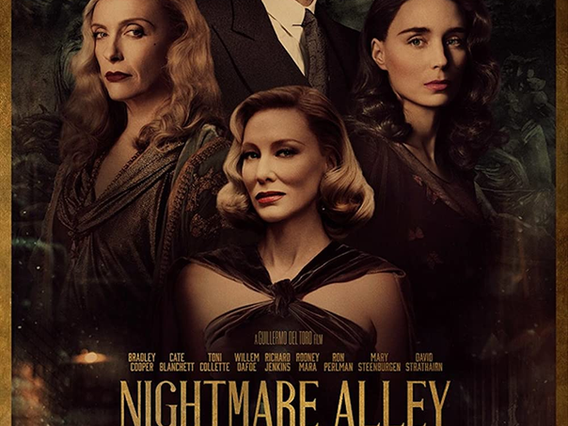Nightmare Alley (2021)—A Slow-Burn Neo-Noir

Legendary filmmaker Guillermo Del Toro has directed a wide range of movies, from twisted fairy tales, to cult-classic comic book films, to even a haunting romance. However, his latest film, Nightmare Alley, adapted from the 1946 novel of the same name, proves to be one of his most unique films in his filmmaking repertoire.
After killing his alcoholic father and burning down their house, Stan Carlisle (played by Bradley Cooper) seeks a job at a local carnival. The carnival head, Clem Hoately (played by Willem Dafoe), hires him and Stan works alongside psychic couple Pete and Zeena Krumbein (played by David Strathairn and Toni Collette). They teach Stan the secrets behind their tricks, but warn him to always remind the patrons that whatever they witnessed was mere stagecraft. Stan grows closer to fellow carney, Molly (played by Rooney Mara), and tells her of his idea of the two running away and running their own two-man show. Molly is hesitant at first, but later joins him. Two years later, the two make a name for themselves in Buffalo, New York, but soon their show begins to draw unwanted attention from psychologist, Dr. Lilith Ritter (played by Cate Blanchett).

This movie piqued my interest when I saw the trailers for it, which advertised the movie as a haunting psychological thriller. However, I was almost ready to quit after watching the first thirty minutes because I felt it was going too slow and didn’t know what direction the plot was going in. It isn’t until the second act when things really start moving along. In a way, this film feels like both a heist and thriller movie. Stan is a conman who works alongside Dr. Ritter to expose secrets from wealthy socialites in Buffalo in addition to conning them of their money. Like all characters who become carried away with any form of power they possess, karma catches up to Stan, and he pays the price for his greed.
Where this film truly shines is in its cinematography. As I’ve stated in my other reviews of Del Toro’s work, the visuals in his films feel more like eye protein than candy, further adding to the storytelling rather than detracting from it. In Nightmare Alley, that praise still stands. In the beginning, the film was almost reminiscent of Tim Burton’s Dumbo. However, it’s not until the second act when the film begins to look more like a Del Toro film, especially with the shots in Dr. Ritter’s office and during several night shots involving Stan at a cemetery. The cinematography gave the scene a mixture of both horror and noir vibes that you can only get from a film from the 1940s.

To complement its visuals, are the performances of Bradley Cooper and Cate Blanchett. Cooper plays the power-hungry Stan masterfully, and his evolution from a troubled young man to power-hungry megalomaniac is portrayed brilliantly. Cate Blanchett brings a chilling performance as the manipulative Dr. Ritter. I especially enjoyed how much emotion she can convey through her icy gaze alone. In addition to these two standout performances, Willem Dafoe brings another layer of charisma to his limited role as Clem Hoately, perfectly disguising his sinister motives with a friendly persona. Lastly, what Del Toro film would be complete without the appearance of Ron Perlman? Perlman brings his signature gruff and tough persona to the film, and despite not being in it for long, I enjoyed seeing him acting out of the Hellboy makeup.
Overall, Nightmare Alley is an enjoyable film with several great performances in addition to its stellar visuals. The only complaint I really have with the film is the pacing in the first act, as I initially felt it was a bit too long. However, looking back, I think it was necessary in order for the ending and twist of events to work. Go check out Nightmare Alley, especially if you’re a Guillermo Del Toro fan. This film may very well be right up your alley!









